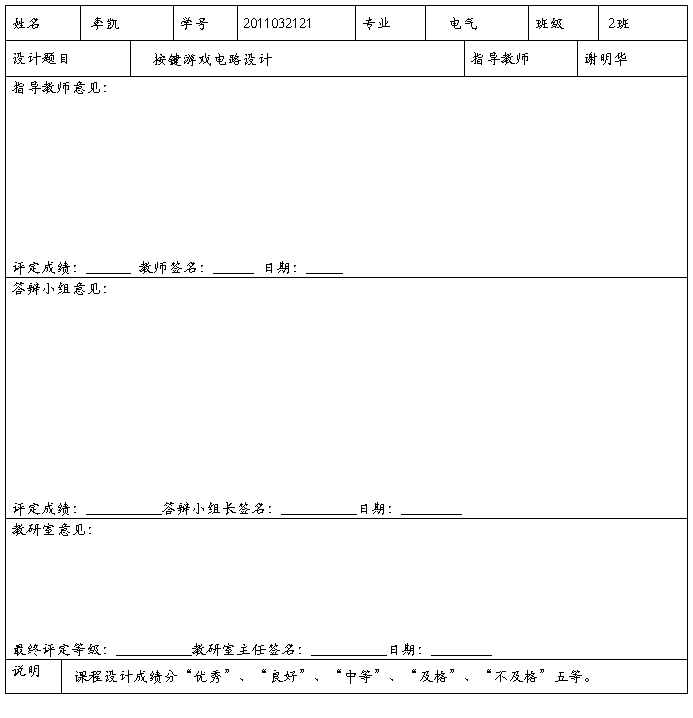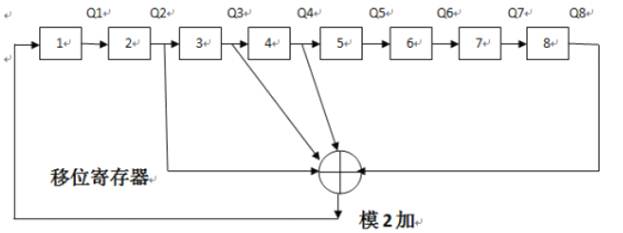EDA课程设计报告
EDA技术课程设计任务书
系(部):电子与通信工程系 专业:电气工程及其自动化 指导教师:谢明华

长沙学院课程设计鉴定表

目录
摘要.................................................................................................................................................. 5
一、 课程设计内容............................................................................................................................ 6
二、系统总体设计............................................................................................................................. 6
三、系统软件设计与实现................................................................................................................... 7
1. 各模块程序说明..................................................................................................................... 7
2.各模块输入输出端口说明:................................................................................................... 18
2.引脚分配及下载过程:.......................................................................................................... 20
四、系统测试与结果分析:.............................................................................................................. 20
1. 源程序仿真波形结果............................................................................................................. 20
2. 采样编码模块仿真波形结果.................................................................................................. 21
3. 分频模块仿真波形结果......................................................................................................... 21
4. 时钟选择模块仿真波形结果.................................................................................................. 21
5. 随机数产生模块仿真波形结果............................................................................................... 22
6. 匹配模块仿真波形结果......................................................................................................... 22
五、心得体会................................................................................................................................... 24
参考文献.......................................................................................................................................... 25
摘要
本次按键游戏课程设计我们主要是应用VHDL语言程序设计,游戏参与者根据系统中的亮灯提示控制相应按键。对按键控制准确,说明参与者的身体越灵活,反应越快。整个系统划分为:编码模块,分频模块,时钟选择模块(即速度控制模块),随机数产生模块,比较匹配模块(即得分模块)等模块,所有算法由软件结合硬件电路来实现,利用描述语言VHDL,并通过XilinxFPGA 芯片实现。
一、课程设计内容
用8个灯作目标,与之对应有8个按键进行控制。每一次8个灯中随机出现一个灯处于“亮”的状态,在灯亮的时间内要求按到对应的按键,若按到则加1分,且灯熄灭;否则失败扣1分。 游戏分1-4四个难度级别,每个级别灯闪亮的速度不同,级别越高,速度越快,灯亮的时间越短。设定初始等级为1,连续成功按键5次加1等级,分数不清0,连续失败5次减1等级, 等级为0时游戏结束。设有暂停/继续和开始/停止功能。
二、系统总体设计
系统框图与说明

各框图说明:
①分频模块是将输入的FPGA 的50MHz 的时钟分频为各种需要的时钟。
②时钟选择模块根据按键匹配的结果,选择对应难度的时钟,即选择A,B,C,D 其中的一个,
然后控制其他的模块。
③随机数产生模块使用的是m 序列,是基于线性反馈移位寄存器的原理实现的。本实验中
使用的是8 级m 序列发生器,产生一个长度为255 个时钟脉冲周期的二进制伪随机序列。
其逻辑框图如下:

取其中的三位(如后三位)通过3-8 译码器来点亮LED 灯。
④采样编码模块,将8 个输入按键进行采样,编码成3 位数。
⑤匹配模块,是把用户的按键输入值与对应于亮灯的随机数进行比较,如果相同则增加分数
值,不同则减少分数值。
三、系统软件设计与实现
1.各模块程序说明
1)顶层模块
entity game is
port(clk50m:in std_logic;
k1,k2,k3,k4,k5,k6,k7,k8:in std_logic;
start:in std_logic;
clear:in std_logic;
en:in STD_LOGIC;
win,lose:out std_logic;
led:out std_logic_vector(2 downto 0);
Sel_selout:out std_logic;
Sel7s:out std_logic_vector(6 downto 0);
sound:out std_logic;
LCD_RS : out STD_LOGIC;
LCD_RW : out STD_LOGIC;
LCD_EN : out STD_LOGIC;
data : out STD_LOGIC_VECTOR (3 downto 0));
end game;
architecture Behavioral of game is
signal A,B,C,D,clk,clkout,clk4,clk500,clk6m:std_logic;
signal key:STD_LOGIC_VECTOR (2 downto 0);
signal mwin,mlose:std_logic;
signal en_A,en_B,en_C,en_D: std_logic;
signal mled:std_logic_vector(2 downto 0);
signal score,highscore:STD_LOGIC_VECTOR(11 downto 0);
signal life:STD_LOGIC_VECTOR (7 downto 0);
--采样编码模块声明
component code
port(clk50m:in std_logic;
clk:in std_logic;
start:in std_logic;
k1,k2,k3,k4,k5,k6,k7,k8:in std_logic;
key:out std_logic_vector(2 downto 0));
end component;
--分频模块声明
component divider
Port ( clk50m : in STD_LOGIC;
start:in STD_LOGIC;
A : out STD_LOGIC;
B : out STD_LOGIC;
C: out STD_LOGIC;
D : out STD_LOGIC;
clk500:out STD_LOGIC;
clk4:out std_logic;
clk6m:out std_logic);
end component;
--时钟选择模块声明
component clk_sel
port(clk50m:in std_logic;
start:in std_logic;
A,B,C,D:in std_logic;
en_A,en_B,en_C,en_D:in std_logic;
leda,ledb,ledc,ledd:out std_logic;
clkout:out std_logic);
end component;
--随机数产生模块声明
component random
Port ( clk : in STD_LOGIC;
start:in STD_LOGIC;
en:in STD_LOGIC;
led : out STD_LOGIC_VECTOR (2 downto 0));
end component;
--匹配模块声明
component compare
port( start:in std_logic;
clear:in std_logic;
en:in std_logic;
clk : in STD_LOGIC;
key : in STD_LOGIC_VECTOR (2 downto 0);
led : in STD_LOGIC_VECTOR (2 downto 0);
win,lose:out STD_LOGIC;
en_A : out STD_LOGIC;
en_B : out STD_LOGIC;
en_C : out STD_LOGIC;
en_D : out STD_LOGIC;
highscore_out:out STD_LOGIC_VECTOR(11 downto 0);
score_out : out STD_LOGIC_VECTOR (11 downto 0);
life_out : out STD_LOGIC_VECTOR (7 downto 0));
end component;
begin
win<=mwin;
lose<=mlose;
led<=mled;
u0:code port map(clk50m,clkout,start,k1,k2,k3,k4,k5,k6,k7,k8,key);
u1:divider port map(clk50m,start,A,B,C,D,clk500,clk4,clk6m);
u2:clk_sel port map(clk50m,start,A,B,C,D,en_A,en_B,en_C,en_D,leda,ledb,ledc,ledd,clkout);
u3:random port map(clkout,start,en,mled);
u4:compare port
map(start,clear,en,clkout,key,mled,mwin,mlose,en_A,en_B,en_C,en_D,highscore,score,life);
u5:music port map(clk6m,clk4,en_A,en_B,en_C,en_D,sound);
u6:lcd port
map(clk500,start,mwin,mlose,highscore,score,life,LCD_RS,LCD_RW,LCD_EN,data);
end Behavioral;
2)采样编码模块
(采样编码模块,将8 个输入按键进行采样,编码成3 位数。)
library ieee;
use ieee.std_logic_1164.all;
entity code is
port(clk50m:in std_logic; --50MHz 的输入时钟
clk:in std_logic; --时钟选择后得到的时钟,即不同难度对应的时钟
start:in std_logic; --开始信号,高电平有效
k1,k2,k3,k4,k5,k6,k7,k8:in std_logic; --8 个输入按键
key:out std_logic_vector(2 downto 0)); --按键编码后得到的编码
end code;
architecture Behavioral of code is
signal flag:std_logic; --标志位
begin
process(clk50m,clk,start)
begin
if start='0' then --初始时令flag=0
flag<='0';
elsif clk50m='1' then--用50MHz 的时钟进行采样编码,且在一个难度时钟内只采样编码一次
if flag='0' then
if k8='1' then
key<="111";
flag<='1'; --flag=1 时表明已经采样编码完毕
elsif k7='1' then
key<="110";
flag<='1';
elsif k6='1' then
key<="101";
flag<='1';
elsif k5='1' then
key<="100";
flag<='1';
elsif k4='1' then
key<="011";
flag<='1';
elsif k3='1' then
key<="010";
flag<='1';
elsif k2='1' then
key<="001";
flag<='1';
elsif k1='1' then
key<="000";
flag<='1';
end if;
end if;
elsif rising_edge(clk) then --在难度时钟的上升沿将flag 置0,表明可进行采样编码
if flag='1' then
flag<='0';
end if;
end if;
end process;
end Behavioral;
3)分频模块
(分频模块是将输入的FPGA 的50MHz 的时钟分频为各种需要的时钟。)
library ieee;
use ieee.std_logic_1164.all;
use ieee.std_logic_unsigned.all;
entity game is
Port ( clk50m : in STD_LOGIC; --50MHz 的输入时钟
start:in STD_LOGIC; --开始信号,高电平有效
A : out STD_LOGIC; --难度A 的周期为2.5 秒
B : out STD_LOGIC; --难度B 的周期为2.0 秒
C : out STD_LOGIC; --难度C 的周期为1.5 秒
D : out STD_LOGIC; --难度D 的周期为1.0 秒
clk500:out STD_LOGIC; --clk500=500Hz
clk4:out std_logic; --clk=4Hz
clk6m:out std_logic); --clk6m=6.25MHz
end game;
architecture Behavioral of game is
signal ma,mb,mc,md,m4,m500,m6m:std_logic:='0';
signal cnt1:integer range 1 to 50000;
signal cnt2:integer range 1 to 6250000;
signal cnt3:integer range 1 to 2;
signal cnt4:integer range 1 to 5;
signal cnt5:integer range 1 to 3;
begin
A<=ma;
B<=mb;
C<=mc;
D<=md;
clk500<=m500;
clk6m<=m6m;
clk4<=m4;
process(clk50m)
variable n:integer range 1 to 5:=1;
begin
if rising_edge(clk50m) then --50MHz8 分频后得到6.25MHz 的信号clk6m
n:=n+1;
if n=5 then
m6m<=not m6m;
n:=1;
end if;
if cnt1=50000 then --50MHz100000 分频后得到500Hz 的信号clk500
m500<=not m500;
cnt1<=1;
else
cnt1<=cnt1+1;
end if;
if cnt2=6250000 then ----50MHz12500000 分频后得到4Hz 的信号clk4
m4<=not m4;
cnt2<=1;
else
cnt2<=cnt2+1;
end if;
end if;
end process;
process(start,m4,md)
begin
if start='0' then --start=0 时初始化
ma<='0';
mb<='0';
mc<='0';
md<='0';
cnt3<=1;
cnt5<=1;
else
if rising_edge(m4) then --4Hz 时钟4 分频后得到1Hz
if cnt3=2 then
cnt3<=1;
md<=not md;
else
cnt3<=cnt3+1;
end if;
if cnt4=5 then --4Hz 时钟10 分频后得到0.4Hz 时
ma<=not ma;
cnt4<=1;
else
cnt4<=cnt4+1;
end if;
if cnt5=3 then --4Hz 时钟6 分频后得到0.67Hz 时
mc<=not mc;
cnt5<=1;
else
cnt5<=cnt5+1;
end if;
end if;
if rising_edge(md) then --1Hz 时钟2 分频后得到0.5Hz 的时
mb<=not mb;
end if;
end if;
end process;
end Behavioral;
4)时钟选择模块
(时钟选择模块根据按键匹配的结果,选择对应难度的时钟,即选择A,B,C,D 其 中的一个,然后控 制 其他的模块。)
library ieee;
use ieee.std_logic_1164.all;
use ieee.std_logic_unsigned.all;
entity clk_sel is
port(clk50m:in std_logic; --50MHz 的输入时钟
start:in std_logic; --开始信号,高电平有效
A,B,C,D:in std_logic; --A,B,C,D 分别对应难度A,B,C,D 的时钟
en_A,en_B,en_C,en_D:in std_logic;--en_A,en_B,en_C,en_D 分别为A,B,C,D 的使能信号
led_selout:out std_logic;
led7s:out std_logic_vector(6 downto 0);--不同的难度用不同的LED 来指示
clkout:out std_logic); --不同的难度输出对应的难度时钟
end clk_sel;
architecture Behavioral of clk_sel is
signal m:std_logic_vector(3 downto 0);
signal clk:std_logic:='0';
Begin
led_selout<='1';
m<=en_A&en_B&en_C&en_D;
clkout<=clk;
process(clk50m)
begin
if start='0' then
clk<='0';
elsif rising_edge(clk50m) then
if m=8 then --当en_A='1'时,时钟对应为难度A 的时钟,且指示难度A 的LED亮
clk<=A;
led7s<="1111001";
elsif m=4 then --当en_B='1'时,时钟对应为难度B 的时钟,且指示难度B 的LED 亮
clk<=B;
led7s<="0100100";
elsif m=2 then --当en_C='1'时,时钟对应为难度C 的时钟,且指示难度C 的LED 亮
clk<=C;
led7s<="0110000";
elsif m=1 then --当en_D='1'时,时钟对应为难度D 的时钟,且指示难度D 的LED 亮
clk<=D;
led7s<="0011001";
else
clk<='0';
end if;
end if;
end process;
end Behavioral;
5)随机数产生模块
(随机数产生模块使用的是m 序列,是基于线性反馈移位寄存器的原理实现的。本实验中使用的是8 级 m 序列发生器,产生一个长度为255 个时钟脉冲周期的二进制伪随机序列。)
entity random is
Port ( clk : in STD_LOGIC; --难度时钟
start:in STD_LOGIC; --开始信号,高电平有效
en:in STD_LOGIC; --暂停信号,en=0 时暂停
led : out STD_LOGIC_VECTOR (2 downto 0)); --产生的三位随机数
end random;
architecture Behavioral of random is
signal m:std_logic_vector(7 downto 0):="10000000";
begin
led<=m(2 downto 0);
process(clk,en,start)
begin
if start='0' then
m<="11000011";
elsif en='0' then
m<=m;
elsif rising_edge(clk) then
m(7 downto 1)<=m(6 downto 0);
m(0)<=m(7) xor m(3) xor m(2) xor m(1);
end if;
end process;
end Behavioral;
6)匹配模块
(匹配模块,是把用户的按键输入值与对应于亮灯的随机数进行比较,如果相同则增加分数值,不同则 减少分数值。)
library ieee;
use ieee.std_logic_1164.all;
entity compare is
port( start:in std_logic; --开始信号,高电平有效
clear:in std_logic; --最高分清零信号,clear=1 时清除最高分纪录
en:in std_logic; --暂停信号,en=0 时暂停
clk : in STD_LOGIC; --clk50m 为50MHz 的输入时钟,clk 为难度时钟
key : in STD_LOGIC_VECTOR (2 downto 0); --key 为编码后得到的编码值
led : in STD_LOGIC_VECTOR (2 downto 0);--led 为产生的三位随机数
win,lose:out STD_LOGIC; --win=1 表明游戏胜利,lose=1 表明游戏失败
en_A : out STD_LOGIC; --难度A 的使能信号
en_B : out STD_LOGIC; --难度B 的使能信号
en_C : out STD_LOGIC; --难度C 的使能信号
en_D : out STD_LOGIC; --难度D 的使能信号
highscore_out:out STD_LOGIC_VECTOR(11 downto 0); --最高分
score_out : out STD_LOGIC_VECTOR (11 downto 0); --当前分数
end compare;
architecture Behavioral of compare is
signal mscore,mhighscore:integer range 0 to 999;
signal result,mwin,mlose:std_logic;
signal cnt1:integer range 0 to 4;
signal cnt2:integer range 0 to 1;
type state is(na,nb,nc,nd);
signal nandu:state;
begin
result<=mwin or mlose; --当result=1 时游戏结束,LCD 上会显示输或赢
win<=mwin;--得5 分加一条命,失误一次扣一分,失误达到2 次扣一条命,当分数为0 时,失误一次不减分,但扣一条命
process(clk,start,en,clear)
begin
if mscore>mhighscore then
mhighscore<=mscore;
else
mhighscore<=mhighscore;
end if;
if start='0' then
mscore<=0; --初始分数为0
cnt1<=0;
mhighscore<=mhighscore;
cnt2<=0;
mwin<='0';
mlose<='0';
nandu<=na;
en_A<='1';
en_B<='0';
en_C<='0';
en_D<='0';
elsif clear='1' then
mhighscore<=0;
elsif en='0' then
mscore<=mscore;
mhighscore<=mhighscore;
elsif rising_edge(clk) then
if result='0' then
if led=key then
elsif mscore=999 then
mwin<='1';
elsif mscore<999 then
mscore<=mscore+1;
end if;
else
if mscore=0 and mlife=0 then
mscore<=0;
mlose<='1';
elsif mlife=0 then
mscore<=mscore;
mlose<='1';
elsif mscore=0 then
mscore<=0;
else
mscore<=mscore-1;
end if;
end if;
end if;
end if;
case nandu is
when na=> --当分数小于5 分时,难度为A
en_A<='1';
en_B<='0';
en_C<='0';
en_D<='0';
if mscore>=5 and mscore<10 then
nandu<=nb;
else
nandu<=na;
end if;
when nb=> --当分数在5-10 之间时,难度为B
en_A<='0';
en_B<='1';
en_C<='0';
en_D<='0';
if mscore>=10 and mscore<15 then
nandu<=nc;
else
nandu<=nb;
end if;
when nc=> --当分数在10-15 之间时,难度为C
en_A<='0';
en_B<='0';
en_C<='1';
en_D<='0';
if mscore>=15 and mscore<20 then
nandu<=nd;
else
nandu<=nc;
end if;
when nd=> --当分数在15 以上时,难度为D
en_A<='0';
en_B<='0';
en_C<='0';
en_D<='1';
nandu<=nd;
when others=>
en_A<='1';
en_B<='0';
en_C<='0';
en_D<='0';
nandu<=na;
end case;
end if;
end process;
process(clk)
begin
if falling_edge(clk) then
if mscore>=900 then
score_out(11 downto 8)<=x"9";
if (mscore-900)>=90 then
score_out(7 downto 4)<=x"9";
score_out(3 downto 0)<=conv_std_logic_vector((mscore-990),4);
elsif (mscore-900)>=80 then
score_out(7 downto 4)<=x"8";
score_out(3 downto 0)<=conv_std_logic_vector((mscore-980),4);
elsif (mscore-900)>=70 then
score_out(7 downto 4)<=x"7";
score_out(3 downto 0)<=conv_std_logic_vector((mscore-970),4);
elsif (mscore-900)>=60 then
score_out(7 downto 4)<=x"6";
score_out(3 downto 0)<=conv_std_logic_vector((mscore-960),4);
elsif (mscore-900)>=50 then
score_out(7 downto 4)<=x"5";
score_out(3 downto 0)<=conv_std_logic_vector((mscore-950),4);
elsif (mscore-900)>=40 then
score_out(7 downto 4)<=x"4";
score_out(3 downto 0)<=conv_std_logic_vector((mscore-940),4);
elsif (mscore-900)>=30 then
score_out(7 downto 4)<=x"3";
score_out(3 downto 0)<=conv_std_logic_vector((mscore-930),4);
elsif (mscore-900)>=20 then
score_out(7 downto 4)<=x"2";
score_out(3 downto 0)<=conv_std_logic_vector((mscore-920),4);
elsif (mscore-900)>=10 then
score_out(7 downto 4)<=x"1";
score_out(3 downto 0)<=conv_std_logic_vector((mscore-910),4);
else
score_out(7 downto 4)<=x"0";
score_out(3 downto 0)<=conv_std_logic_vector((mscore-900),4);
end if;
if mhighscore>=900 then
highscore_out(11 downto 8)<=x"9";
if (mhighscore-900)>=90 then
highscore_out(7 downto 4)<=x"9";
highscore_out(3 downto 0)<=conv_std_logic_vector((mhighscore-990),4);
elsif (mhighscore-900)>=80 then
highscore_out(7 downto 4)<=x"8";
highscore_out(3 downto 0)<=conv_std_logic_vector((mhighscore-980),4);
elsif (mhighscore-900)>=70 then
highscore_out(7 downto 4)<=x"7";
highscore_out(3 downto 0)<=conv_std_logic_vector((mhighscore-970),4);
elsif (mhighscore-900)>=60 then
highscore_out(7 downto 4)<=x"6";
highscore_out(3 downto 0)<=conv_std_logic_vector((mhighscore-960),4);
elsif (mhighscore-900)>=50 then
highscore_out(7 downto 4)<=x"5";
highscore_out(3 downto 0)<=conv_std_logic_vector((mhighscore-950),4);
elsif (mhighscore-900)>=40 then
highscore_out(7 downto 4)<=x"4";
highscore_out(3 downto 0)<=conv_std_logic_vector((mhighscore-940),4);
elsif (mhighscore-900)>=30 then
highscore_out(7 downto 4)<=x"3";
highscore_out(3 downto 0)<=conv_std_logic_vector((mhighscore-930),4);
elsif (mhighscore-900)>=20 then
highscore_out(7 downto 4)<=x"2";
highscore_out(3 downto 0)<=conv_std_logic_vector((mhighscore-920),4);
elsif (mhighscore-900)>=10 then
highscore_out(7 downto 4)<=x"1";
highscore_out(3 downto 0)<=conv_std_logic_vector((mhighscore-910),4);
else
highscore_out(7 downto 4)<=x"0";
highscore_out(3 downto 0)<=conv_std_logic_vector((mhighscore-900),4);
end if;
end process;
end Behavioral;
2.各模块输入输出端口说明:
1)顶层模块game
输入信号IN:
clk50m:in std_logic; --50MHz 的输入时钟
k1,k2,k3,k4,k5,k6,k7,k8:in std_logic; --8 个输入按键
start:in std_logic; --开始信号,高电平有效
clear:in std_logic; --最高分清零信号,clear=1 时清除最高分纪录
en:in STD_LOGIC; --暂停信号,en=0 时暂停
输出信号OUT:
win,lose:out std_logic; --win=1 表明游戏胜利,lose=1 表明游戏失败
led:out std_logic_vector(2 downto 0); --产生的三位随机数,送到74LS138进行译码,从而点亮一个LED
leda,ledb,ledc,ledd:out std_logic; --不同的难度分别用不同的LED 灯来指示
sound:out std_logic; --为输出的喇叭信号
LCD_RS : out STD_LOGIC;
LCD_RW : out STD_LOGIC;
LCD_EN : out STD_LOGIC;
data : out STD_LOGIC_VECTOR (3 downto 0)); --数据信号输出
2)采样编码模块code
(输入为50MHz 的时钟信号clk50m,选择的难度信号clk,
开始信号start,以及八个按键;输出为编码值key。)
输入信号IN:
clk50m:in std_logic;
clk:in std_logic;
start:in std_logic;
k1,k2,k3,k4,k5,k6,k7,k8:in std_logic;
输出信号OUT:
key:out std_logic_vector(2 downto 0)
3)分频模块divider
(输入为50MHz 的时钟信号,开始信号start;
输出为A,B,C,D 四种难度的时钟。)
输入信号IN:
clk50m : in STD_LOGIC;
start:in STD_LOGIC;
输出信号OUT:
A : out STD_LOGIC;
B : out STD_LOGIC;
C: out STD_LOGIC;
D : out STD_LOGIC;
clk500:out STD_LOGIC;
clk4:out std_logic;
clk6m:out std_logic
4 )时钟选择模块clk_sel
(输入为A,B,C,D 四种难度的时钟,50MHz 的时钟clk50m,开始信号start,
en_A,en_B,en_C,en_D 四种时钟的选择信号;
输出为leda,ledb,ledc,ledd 四个对应不同难度的LED,选择的A,B,C,D 难度中的一个时钟。)
输入信号IN:
clk50m:in std_logic;
start:in std_logic;
A,B,C,D:in std_logic;
en_A,en_B,en_C,en_D:in std_logic;
输出信号OUT:
leda,ledb,ledc,ledd:out std_logic;
clkout:out std_logic
5)随机数产生模块random
(输入为选择的难度时钟clk,暂停信号en,开始信号start;
输出为产生的三位随机数。)
输入信号IN:
clk : in STD_LOGIC;
start:in STD_LOGIC;
en:in STD_LOGIC;
输出信号OUT:
led : out STD_LOGIC_VECTOR (2 downto 0)
6)匹配模块compare
(输入选择的难度时钟clk,最高分清零信号clear,暂停信号en,开始信号start,编码key,
随机数led;
输出为最高分highscore_out,当前分数score_out,不同难度的选择信号 en_A,en_B,en_C,en_D,输信号lose,赢信号win。)
输入信号IN:
start:in std_logic;
clear:in std_logic;
en:in std_logic;
clk : in STD_LOGIC;
key : in STD_LOGIC_VECTOR (2 downto 0);
led : in STD_LOGIC_VECTOR (2 downto 0);
输出信号OUT:
win,lose:out STD_LOGIC;
en_A : out STD_LOGIC;
en_B : out STD_LOGIC;
en_C : out STD_LOGIC;
en_D : out STD_LOGIC;
highscore_out:out STD_LOGIC_VECTOR(11 downto 0);
score_out : out STD_LOGIC_VECTOR (11 downto 0);
life_out : out STD_LOGIC_VECTOR (7 downto 0));
2.引脚分配及下载过程:
引脚分频图如下:


四、系统测试与结果分析:
1.源程序仿真波形结果
2.采样编码模块仿真波形结果

由仿真图可知,在一个clk 周期内虽然有多次按键输入,但只有第一次的按键有效,即在一
个clk 周期内只采样编码一次。
3.分频模块仿真波形结果

由于A,B,C,D 的频率较小,得不到仿真结果,所以将代码烧录到板子上通过LED 灯的亮灭来
观察a,b,c,d 的频率,观察结果与预期相符。
4.时钟选择模块仿真波形结果

5.随机数产生模块仿真波形结果

由仿真图可知,产生的led 可认为是随机数。
6.匹配模块仿真波形结果




由以上波形可看出,匹配时,分数增加一分,连续分数增加5分,难度增加一级,分数在5
以下时难度为A,在5-10 之间时难度为B,在10-15 之间时难度为C,在15 以上时难度为D,
不匹配时,分数减一分,连续分数减5次减1等级,等级为0时游戏结束。最高分只升不降。
最高分比当前分数滞后一个周期。当等级为0 时游戏结束。
五、心得体会
这次课程设计对于没学号EDA技术的同学来说是困难的。在设计程序的初期阶段我对于整个VHDL程序设计流程的方向性的把握不是很准确,刚开始在模块的设计就出现了很大的问题,对于各个模块功能实现的具体代码把握也不是很明确,在这些模块中,比较有难度的是分数与按键匹配的判定,以及判定之后的加分升级,还有一个是LED的显示,在查了资料后才终于得出了结论。
在这里,我想要指出的是匹配模块,最先是用难度时钟进行匹配加减分,但是仿真得不到正确结果,于是就改用50MHz 的频率进行匹配加减分,需要设置标志位,保证在一个难度时钟内只匹配一次,另外需要将编码延时一个难度周期,只有在前后两次按键不一样时才进行匹配,这样的好处就是分数更新很快,几乎没有延时,但缺点就是如果前后两次按键一样时就不进行匹配,既不加分也不减分,不满足要求。最后我们采用的办法是用难度时钟的上升沿进行匹配,在难度时钟的下降沿进行加减分,这样能满足要求,不过加减分仍有一定的延迟。
参考文献
潘松、黄继业著《EDA技术实用教材》——VHDL版(第四版) 科学出版社
-
课程设计报告
1课程设计目的课程设计是船舶设计原理课程重要的实践性教学环节是培养学生掌握船舶设计基本原理和能力的技术基础主尺度论证与总布置设计是…
-
课程设计报告内容
一设计目的1强化上机动手能力在理论和实践的基础上进一步巩固数据结构课程学习的内容掌握工程化软件设计的基本方法2掌握图的创建和应用3…
-
课程设计报告
中国计量学院信息工程学院课程设计报告课程设计名称系统设计与仿真课程计二级学院信息工程学院专业班级10电信2班学姓成绩号名10003…
-
课程设计报告模板
信息科学与工程学院高级语言程序设计课程设计报告学生成绩管理系统学科专业计算机科学与技术班级1301学号指导教师唐郑熠讲师学生二零年…
-
课程设计报告
扬州大学数据结构课程设计报告课题名称姓名学院系科班级指导老师日期自来水管架设问题广陵学院陈宏建1一课程设计的题目自来水管理架设问题…
-
心理咨询工作总结
心理健康可以促进大学生全面发展健康的心理品质是大学生全面发展的基本要求,也是将来走向社会,在工作岗位上发挥智力水平、积极从事社会活…
-
全国科普日活动总结
“全国科普日活动”总结崇义街道科协为了组织开展好20xx年的全国科普日活动,区科协发了一个文件(涪区科协发[20xx]39号),关…
-
广告设计专业毕业实习总结报告
毕业实习总结报告经过了四年的理论学习,使我们对平面设计有了基本掌握,对于平面设计这个专业也有了一个系统的学习和掌握。我们即将离开大…
-
教师专业发展知识点总结
1专业是指一群人经过专门教育或训练,具有较高深和独特的专门知识与技术,按照一定专业标准进行专门化的处理活动,从而解决人生和社会问题…
-
职业生涯规划大赛总结
工作总结经济与商业学院关于阜阳师范学院第三届大学生职业规划设计大赛暨大学生创业大赛总结一、总体概况为了积极响应学校关于第四届大学生…